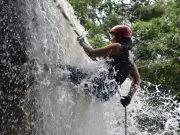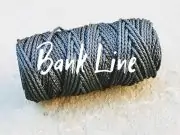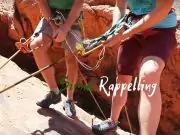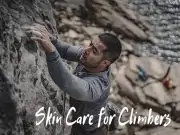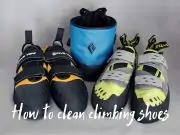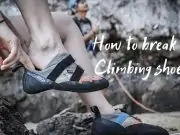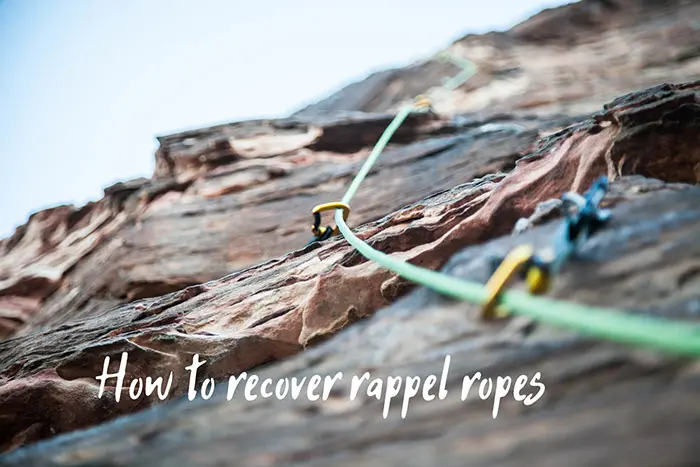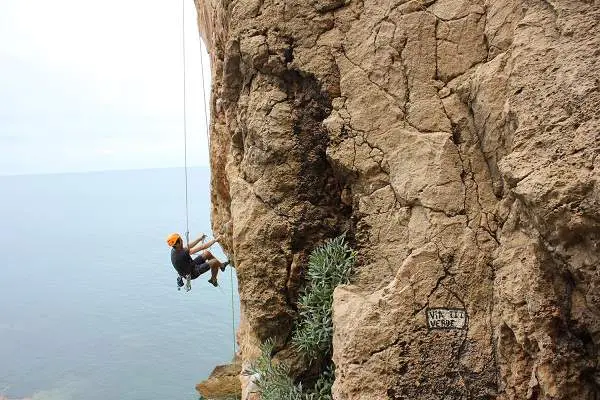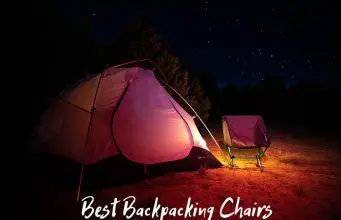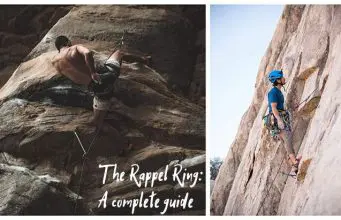Here’s how to properly recover your rappel ropes.
Recovering the rappel rope sounds like an easy enough task on paper, but things can get complicated quickly in real life. It happened to me too, I’ll admit it: I managed to get my ropes stuck after a rappel and I had a very hard time bringing them back down safely and in good condition. In order to help you avoid these issues, I decided to write this quick guide. As long as you follow each of these guidelines to the letter, you should have no issues retrieving your rappel ropes quickly and securely. After all, ropes aren’t exactly cheap, and leaving your rappelling equipment behind is a breach of climbing etiquette anyway.
While there are a few specific steps that you can follow in order to bring your ropes down after a rappel, there’s one more important aspect that you need to be aware of: rappelling properly, in an organized fashion, without twisting or tangling your ropes will make it easier for you to bring them down after you’ve reached the ground.
Oh and if you need some guidance to find a reliable rappel rope this year, check out my complete rappelling rope guide right here!
Here are some tips that make recovering the rappel rope easier.
- Let’s say you’re done with your climb and you’re getting ready to go back down using a set of rappelling ropes. The best thing you can do is to tie the ropes together using a double figure-eight fisherman’s knot. If you need help tying this not, have a look at my guide of the best climber knots. It will seriously help you out.
- Stack these ropes separately and throw them down separately in order to make sure that they won’t tangle.
- Make sure the tails of the ropes are secured and that the knot between them is rock-solid. In other words, perform a basic safety check before you rappel.
- Keep the strands of rope separated using a guide finger. If you’re rappelling with a buddy, the last person down needs to separate the ropes in order to ensure that they won’t become tangled. He or she can do this by keeping one finger of the guiding hand right above the rappel device and between the ropes.
- Keep in mind that nature can get in the way. Grooves, rock notches, flakes, and sharp edges can hang up the rope. Make sure to place the rope properly in order to avoid these natural obstacles. The key here is to spot them early and plan accordingly.
- Make adjustments if necessary! After the first climber has managed to rappel down successfully, have him or her test the ropes by pulling on them. If they pull easily, everything should be ok. However, if there is some unusual resistance, you will likely need to adjust the entire system at the top.
- You can move the large knot that ties the ropes a bit lower down the cliff in order to eliminate the extra resistance.
What you need to ask yourself before rappelling.
Perform a quick check-up before you start your rappel! Make sure you know which rope to pull and check the condition of the ropes carefully.
You need to take note of which side of the descending ring the knot is on. That’s the side that you need to pull. Rope colors will also help you in this regard. They are usually either blue or orange. Take a mental note of which color you need to pull, as this will help you a lot.
Inspect the ropes and acknowledge if they are crossed over each other or twisted on the slings. Both strands of the rope should fall cleanly on the face of the wall from the anchor. A single twist can hang the rope and make it very difficult or even impossible to pull. Ropes can also twist on each other as you rappel, but you can keep them separated using a guide finger.
Rappel rope recovery process.
Assuming you’ve reached the ground or your next rappel station safely, you can now proceed to recover your ropes from the top. If you followed the steps above carefully, you should have no issues with twists or hang-ups, and you should be able to pull them down right away, easily and smoothly.
However, even if the ropes are easy to pull, there are some things that you need to watch out for. These are basic safety guidelines. You think of them as “things that can go wrong while pulling the ropes.”
- Don’t forget to yell “Rope” when you start the recovery process. This will alert everyone around you that one or more ropes are coming down. These ropes might bring down some rocks, or they can lash about and hurt someone. Remember that rappel ropes are heavy, and they can cause injury in some cases.
- Keep an eye out on the free end of the rope. It can whip about and hurt you badly if you’re not paying attention. Stay out of its way and you should be fine.
- Since I mentioned falling rocks, make sure you’re wearing a high-quality climbing helmet. I wrote a complete guide about climbing helmets, and you can check that out as well if you need some guidance. Keeping your head down is also a good idea, but you also need to watch the rope carefully, so this can be tricky.
What if I was rappelling with a single rope?
Rappelling with a single rope is definitely doable, even though it’s not widely practiced. I always prefer to rappel with two ropes myself, but if you want to do it this way, more power to you! However, I hope you know that in order to rappel with a single rope, you need to use a relatively lengthy one – both of its ends need to reach the ground. Of course, if you’re rappelling over very short distances, a medium-sized rope will do just fine.
- Once both ends have reached the ground, you need to tie a double figure-eight knot on the rope bight.
- Pull one end of the rope and thread it through two rings on the anchor.
- As for rappelling with a single rope, make sure to rappel on the side that’s opposite the knot. This will prevent the rope from dropping through.
- Now’s a good time to check everything just the way I described above. Even though you rappelled with a single rope, you still need to check the knot and avoid any hangs or snags.
- In order to retrieve your single rappel rope, pull the part of the rope that has a knot at the top. You shouldn’t have any trouble recovering this rope, as it should fall right off.
This is one of the safest and most predictable ways to rappel with a single rope and recover it easily afterward. Depending on the terrain, the rappel length, and the weather conditions, there might be some other ways of going about it.
However, even though experimental rappelling techniques are gaining a bit of popularity, I would never try them out myself because I simply enjoy living too much. If you ask me, tried and proven methods that work time and time again are the only ones that should be practiced nowadays.
Conclusion.
I hope that you now have a better understanding of rappel rope recovery techniques. As I mentioned before, this isn’t a particularly difficult process, but it does require a bit of know-how and some basic skills. Beginners will likely have some issues with the recovery process, but practice makes perfect, right?
If you have anything that you would like to add, whether we’re talking about personal experiences or extra tips, feel free to speak your mind. Until then, stay safe out there!



